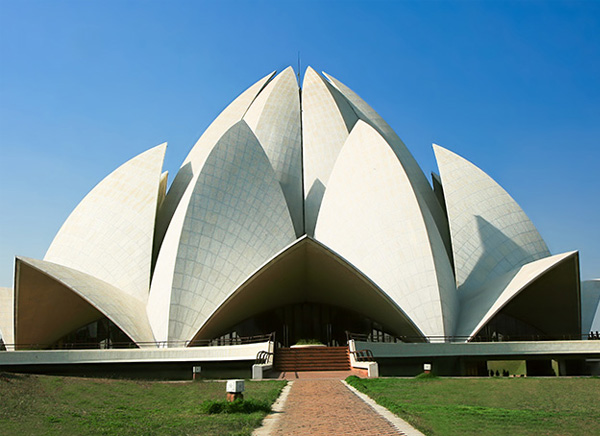The temple having a futuristic design and awarded by many organisations, who organise architectural awards is: The Lotus Temple, located in Delhi, India, is a Bahá?í House of Worship that was dedicated in December 1986. Notable for its flowerlike shape, it has become a prominent attraction in the city. Like all Bahá?í Houses of Worship, the Lotus Temple is open to all, regardless of religion or any other qualification.

The building is composed of 27 free-standing marble-clad "petals" arranged in clusters of three to form nine sides, with nine doors opening onto a central hall with a height of slightly over 34.27 metres and a capacity of 2,500 people. The Lotus Temple has won numerous architectural awards and has been featured in many newspaper and magazine articles.
The Bahá?í Faith teaches that a Bahá?í House of Worship should be a space for people of all religions to gather, reflect, and worship. Anyone may enter the Lotus Temple irrespective of religious background, sex, or other distinctions, as is the case with all Bahá?í houses of worship. The sacred writings of not only the Bahá?í faith but also other religions can be read and/or chanted, regardless of language; on the other hand, reading nonscriptural texts is forbidden, as are delivering sermons or lectures, or fund-raising. Musical renditions of readings and prayers can be sung by choirs, but no musical instruments can be played inside. There is no set pattern for worship services, and ritualistic ceremonies are not permitted.
All Bahá?í Houses of Worship, including the Lotus Temple, share certain architectural elements, some of which are specified by Bahá?í scripture. ?Abdu'l-Bahá, the son of the founder of the religion, stipulated that an essential architectural character of a House of Worship is a nine-sided circular shape. While all current Bahá?í Houses of Worship have a dome, this is not regarded as an essential part of their architecture. Bahá?í scripture also states that no pictures, statues or images be displayed within the House of Worship and no pulpits or altars be incorporated as an architectural feature.

Inspired by the lotus flower, the design for the House of Worship in New Delhi is composed of 27 free-standing marble-clad "petals" arranged in clusters of three to form nine sides. The nine doors of the Lotus Temple open onto a central hall slightly more than 40 metres tall that can seat 1,300 people and hold up to 2,500 in all. The surface of the House of Worship is made of white marble from Penteli mountain in Greece, the same marble used in the construction of many ancient monuments and other Bahá?í buildings. Along with its nine surrounding ponds and gardens, the Lotus Temple property comprises 26 acres (105,000 m²; 10.5 ha). Lotus temple is situated near Okhla NSIC and Kalkaji Mandir metro station is just 500 meters away. The temple is located in the village of Bahapur in New Delhi, National Capital Territory of Delhi.

The structural design was undertaken by the UK firm Flint and Neill over the course of 18 months, and the construction was done by ECC Construction Group of Larsen & Toubro Limited at a cost of $10 million. The major part of the funds needed to buy this land was donated by Ardishír Rustampúr of Hyderabad, Sindh, who gave his entire life savings for this purpose in 1953. A portion of the construction budget was saved and used to build a greenhouse to study indigenous plants and flowers that would be appropriate for use on the site. The temple's total electricity use of 500 kilowatts (kW), 120 kW is provided by solar power generated by solar panels on the building. This saves the temple 120,000 rupees per month. It is the first temple in Delhi to use solar power.
• 2000, GlobArt Academy, based in Vienna, Austria, presented its "GlobArt Academy 2000" award to the architect of the Lotus Temple, Fariborz Sahba, for "the magnitude of the service of [this] Taj Mahal of the 20th century in promoting the unity and harmony of people of all nations, religions and social strata, to an extent unsurpassed by any other architectural monument worldwide."
• 1994 edition of Encyclopaedia, in its "Architecture" section gives recognition to the Temple as an outstanding achievement of the time.
• 1988, the Illuminating Engineering Society of North America conferred the Paul Waterbury Outdoor Lighting Design Award - Special Citation for Exterior Lighting.
• 1987, the Interfaith Forum on Religion, Art and Architecture, Affiliate of the American Institute of Architects, Washington, D.C., gave their First Honour award for "Excellence in Religious Art and Architecture" 1987 to Mr. F. Sahba for the design of the Bahá?í House of Worship near New Delhi.
• 1987, the architect of the Bahá?í House of Worship, Mr. Fariborz Sahba, was presented the award for excellence in religious art and architecture by the UK-based Institution of Structural Engineers for producing a building "so emulating the beauty of a flower and so striking in its visual impact".